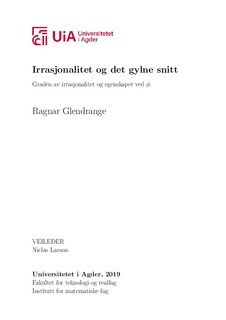| dc.description.abstract | The golden ratio has been known for over a thousand years through written sources,and possibly for an even longer time without having been recorded in writing. Theratio is most likely best known for its relationship to the Fibonacci Sequence, ar-chitecture and art; however, it also occurs naturally (by approximation) in sunflow-ers, pinecones, and growth patterns, among other things, and in abstract geometryit may appear in contexts where it might not be altogether expected. What, then,is it that makes the golden ratio so extraordinary?The answer lies largely in the degree of irrationality. The degree of irrationalityis determined by the use of continued fractions and by how easily the number isapproximated by rational numbers. In this sense, an irrational number that is easilyapproximated by a rational number could be considered less irrational than an ir-rational number that will not be as easily approximated by rational numbers whenusing rational numbers of the same size.With a point of departure in this concept, the golden ratio will not only bean irrational number; it will indeed be the most irrational number as it is notapproximated very well by rational numbers compared to other irrational numbers.It is among the numbers which exist in the uppermost category of irrationality thatthe interesting qualities start to become apparent.A good way to illustrate this irrationality is by means of what in this paperwill be called ‘orchard problems’. This concept is based on orchards in which fruittrees, for example, have been planted systematically in rows and columns that areplaced perpendicular to each other, in which case it will at some points be possibleto see through the entire orchard. In the mathematical representation the orchardis infinite, the trees are replaced by points in all coordinates with positive integersasxandyvalues, and the observer is in the origin. The line of sight of the observerwould be represented by a linear function with a gradient. It turns out that if thegradient is a rational number, the line of sight will be blocked by the point which hasxandycoordinates corresponding to the numerator and denominator of the rationalgradient. On the other hand, all irrational gradients will ensure that the observer’sline of sight will never be blocked by any points, and the observer will be able to seeright across the infinite orchard containing an infinite number of point-trees. Theline of sight which at any given time has the largest distance to the closest pointswill have the gradientφ, because it is the most irrational number.The most irrational numbers are also the best numbers to use as distributioncoefficients for distributing points along a straight line, a circle perimeter or outwardsin a spiral. The rational numbers will not work well as distribution figures, as pointswill thus eventually coincide. The least irrational numbers, that is, those that areeasily approximated by rational numbers, will place the points unevenly, causingthem to almost coincide. | nb_NO |

